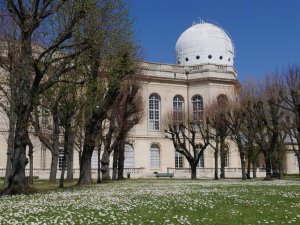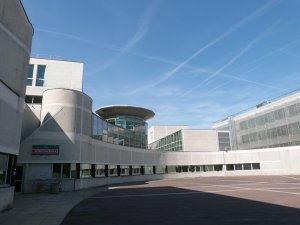Matter / photon interactions
Atoms, molecules, and grains probe the chemical evolution of the Universe, from the most distant metal-poor galaxies, to the densest phases of the interstellar medium (e.g. star forming regions) rich in complex molecules. On the observational side, such studies undergo a rapid expansion with the recent development of the Herschel, APEX, SOFIA, ALMA, and (soon) NOEMA submillimeter telescopes. Many molecular lines, long thought as tracers of dense and cold gas, have thus been detected in hostile environments, weakly shielded from the UV radiation field, including active galaxies at high redshift.

All these discoveries raise several questions. What are the contributions of the different phases of the interstellar medium (HII regions / Warm Ionized Medium, Warm Neutral Medium, Cold Neutral Medium) in the emissions of atomic and molecular lines and what can we deduce about their structure and evolution ? Are the current models able to explain the chemical richness of astronomical environments and the various spatial and spectral correlations observed in galactic and extragalactic media ? What are the main chemical and physical processes involved ? Finally, what information can we derive from the observations, in particular regarding the energy balance of galaxies, the timescale of the cycle of matter and its evolution with metallicity ?
In order to solve those issues, our team is specialized in the conception and development of numerical models designed to treat all the coupling between the interstellar matter, the radiation field at all wavelengths, and the high energy particles. Most of the numerical developments we propose are done in the framework of the Meudon PDR code, a public model (http://ism.obspm.fr) which describes the chemical and thermal structures of an interstellar cloud pervaded by an external radiation field. The specificity of our approach is to describe as precisely as possible the details of the microphysical processes at play and to estimate their global impact on the physics of the environment. Our work is therefore build on the results of numerous theoretical calculations and laboratory experiments (e.g. spectroscopy, collisions) and is thus strongly interdisciplinary, at the interface of chemistry, dynamics, radiative transfer, and atomic and molecular physics.
Find below a few of our most recent results.
Temperature fluctuations of interstellar grains
Interstellar grains are not always at thermal equilibrium but may fluctuate over a wide range of temperature. To study the process we have recently developed a new method to solve the statistical equilibrium of the system. Using the method on real astronomical sources, we have shown that this aspect of the microphysics of grains has a decisive impact on all the surface processes, in particular the chemical reaction, the ortho-para conversion and the desorption mechanisms. The fact that small grains naturally span a whole distribution of temperatures strongly modifies the intensities of several H2 lines predicted in galactic PDRs compared to traditional models.
Excitation of CO in PDRs
One of the most vivid results of the Herschel, APEX, and ALMA observatories is the detection of the pure rotational ladder of carbon monoxyde up to high energy transitions (J = 49-48) in a variety of astrophysical environments, including the galactic and extragalactic interstellar matter. In contrast to traditional models which usually explain those observations by combining the contributions of several media (PDR, shock, XDR), we have shown that a detailed treatment of the microphysical processes of dust and gas offers an alternative scenario. With such treatment, a single PDR component has been found to be sufficient to reproduce the intensities of all the rotational lines of CO observed in the NGC 7023 nebula and in the Orion bar.

Surface chemistry
Many interstellar molecules are known to be formed on dust surfaces. To model the process as precisely as possible, we have revised our treatment of surface chemistry in the PDR code. Both physisorption and chemisorption sites have been added in the computation of H2 production. We have also developed a new formalism to describe the formation of grain mantles and the adsorption and desorption of atomic and molecular species, which has been tested on the formation of methanol and formaldehyde. We have shown that these improvements are necessary to explain the formation of H2 at the border of PDRs and to interpret the abundances of several molecules observed in the Horsehead nebula with the Plateau de Bure interferometrer.

Nitrogen chemistry in the interstellar medium
A major part of our work consists in keeping track of the latest improvements of the kinetic chemical database, in coordination with several colleagues physicists and chemists, in order to update our chemical reaction networks. Focusing on nitrogen chemistry, we have recently built a new chemical network containing D, 13C, and 15N that we used to study fractionation processes in the interstellar medium. This network has been tested with several dense clouds and prestellar core conditions. Most notably, we found that the nitrile and isocyanide are systematically depleted in 13C in these media, a result that casts doubts on previous interpretation of observations
Diagnostics of the multiphase interstellar medium
Interpreting extragalactic observations is tricky. Indeed, with the resolution of the current instruments, the lines of sight necessarily encompass the contributions of a multitude of different environments, where the chemistry is driven by the radiation field (HII region, PDRs, XDRs), the cosmic rays (CRDRs), or the dissipation of mechanical energy (shock, TDRs). To treat as many of these scenario as possible, we have recently extended the scope of the Meudon PDR code by implementing all the interaction between X-ray photons and the interstellar matter. This code gave us access to the atomic and molecular transitions sensitive to the X-ray field, and has been successfully used to interpret observations of the Large Magellanic Cloud.

Publications récentes ou significatives
Bron, E. ; Le Bourlot, J. ; Le Petit, F., 201 4,A&A, 569, 100
Godard, B. ; Cernicharo, J., 2013, A&A, 550, 8
Le Bourlot, J. ; Le Petit, F. ; Pinto, C. ; Roueff, E. ; Roy, F., 2012, A&A, 541, 76
Le Petit, F. ; Nehmé, C. ; Le Bourlot, J. ; Roueff, E., 2006, ApJS, 164, 506
Le Petit, F. ; Ruaud, M ; Bron, E. ; Godard B., et al., 2015, A&A, in press.
Levrier, F. ; Le Petit, F. ; Hennebelle, P. ; Lesaffre, P. ; et al., 2012 A&A, 544, 22
Neufeld, D. A. ; Roueff, E. ; Snell, R. L. ; Lis, D. ; et al., 201 2,ApJ, 748, 37
Roueff, E. ; Loison, J. C. ; Hickson, K. M., 2015, A&A, 576, 99
Sternberg, A. ; Le Petit, F. ; Roueff, E. ; Le Bourlot, J., 2014, ApJ, 790, 10
Zanchet, A. ; Godard, B. ; Bulut, N. ; Roncero, O. ; et al., 2013, ApJ, 766, 80
Membres de l’équipe
Bron Emeric |
Godard Benjamin |
Languignon David |
Le Bourlot Jacques |
Le Petit Franck |
Rabasse Jean-François |
Roueff Evelyne |
Stephan Gwendoline |





